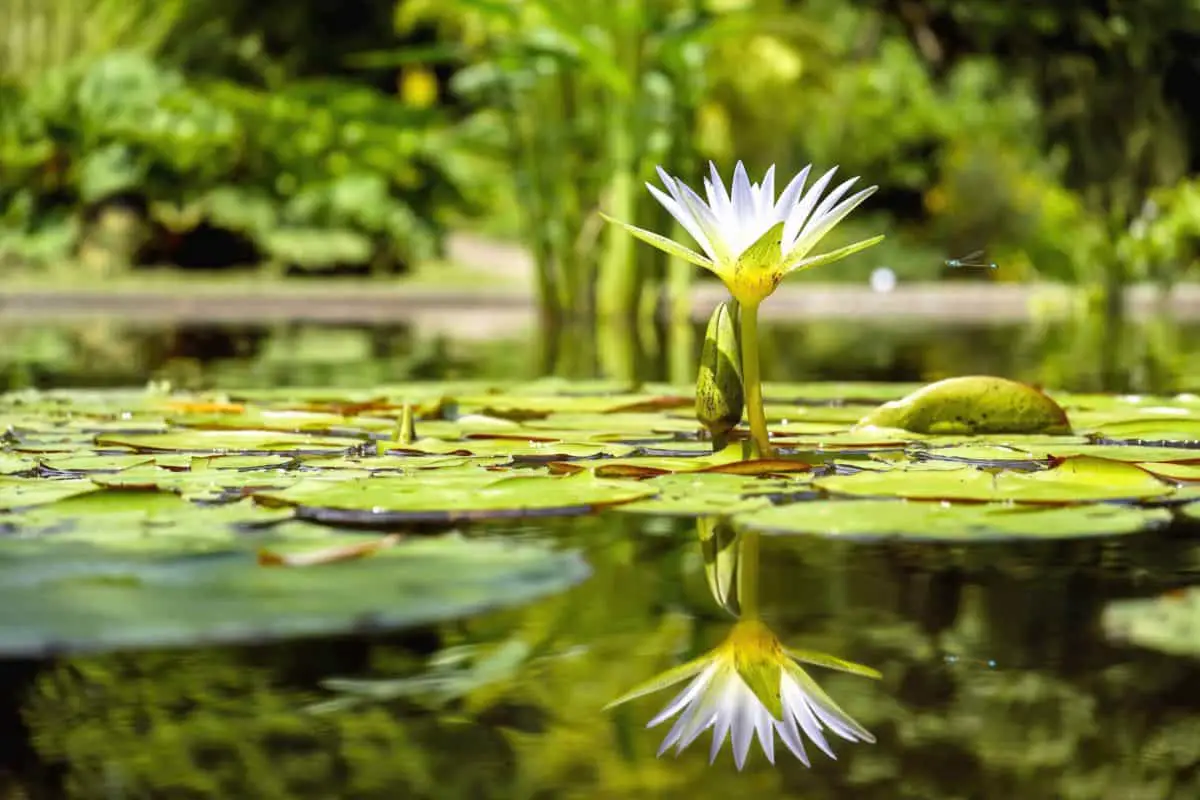
Our aquatic plants They are those that, unlike terrestrial ones, are adapted to environments with high humidity. There are some that even live in water, such as in lakes or rivers. They are very interesting to have in a garden pond, as it gives them a new, very elegant appearance.
These are plants that we usually see very often in nurseries and homes, since they are very easy to care for and maintain. Let’s see what aquatic plants are.
What is the definition of aquatic plants?

Our protagonists, also known as hydrophytes or hygrophytes, are plants that are adapted to live in humid or aquatic environments. They can be algae, or vascular plants, pteridophytes and angiosperms (the latter with showy flowers). Normally they are strongly rooted in the silt that is found at the bottom of the waters, but there are others that remain floating on the surface.
Generally live in freshwater environmentslike lakes, rivers or ponds, but we can also find them in salt water environmentswhere the mangroves which are trees whose roots resist the high concentration of salts in the intertidal zone near the mouth of fresh water courses in tropical regions.
How are they classified?
Depending on where they are found, three classes of aquatic plants are distinguished:
- Floating plants: are those that, as their name suggests, float on the surface. Its roots may or may not anchor to the bottom. Examples: salvia swimming Nymphaea or Flowing water.
- Submerged plants: are those that live under water, either anchoring to the bottom or not. Examples: cabomba australis (aquatic nettle), dense egeria o Vallisneria spiralis.
- Emerging plantsThese are the ones that take root at the bottom, keeping leaves, flowers and stems in the open air. Examples: Cyperus papyrus (papyrus), Juncus (reed), or the Oryza sativa (rice).
Types of aquatic plants
There are many types of aquatic plants. In fact, there are so many that it would be impossible to discuss all of them in one article. So what we will do is talk to you about the ones that are most important, whether in a garden, in a pond and / or in the kitchen.
Aldrovanda

Image – Wikimedia / Krzysztof Ziarnek, Kenraiz
The Aldrovanda it is a floating aquatic carnivore, with stems up to 20 centimeters long from which leaves sprout so thin that they look like “hairs”. It is perennial, and has tiny little traps that trap very small insects, such as mosquito larvae, so it is highly recommended to grow it in areas where these animals proliferate, as is the case in the Mediterranean region. Of course, keep it in distilled water and protect it from frost.
Rice (Oryza sativa)

Image – Wikimedia / Krzysztof Golik
El rice It is an emergent aquatic plant of the grass family. It lives for several months, and in that time it develops stalks one and a half meters high, as well as grouped flowers which sprout from a stalk. The seeds is the rice itself, and as you know it is the main ingredient in many, many recipes.: paella, Cuban rice, three delights rice, and so on.
Rush (Juncus)

Image – Flickr / Amadej Trnkoczy
El rush it is a perennial herbaceous plant that reaches a maximum height of 90 centimeters. It develops elongated, more or less straight and green leaves, and blooms producing brown compound flowers. It may not be very interesting as an ornamental plant, but it is widely used to make baskets for example. In addition, it tolerates the soil and the sea wind very well, making it an option to grow in gardens near the sea. Resists up to -7ºC.
lenticular (Utricularia vulgaris)
-
Image – Flickr / Len Worthington
-
Image – Flickr / Kirill Ignatyev
The lentibularia is a floating or submerged aquatic that has stems of more or less 1 meter long, with bilobed leaves that sprout from its base and that have tiny sacs called utricles that trap prey. From its center arises a flower stalk, at the end of which sprout yellow flowers. In cultivation it has to be put in a pond with rain or distilled water. Resists up to -10ºC.
Lotus (Nelumbo nucifera)

Image – Wikimedia / TANAKA Juuyoh
El lotus or Nile rose It is a floating aquatic whose leaves measure up to 1 meter in diameter, and flowers between 15 and 25 centimeters in diameter. These are pink or white, and give off a very pleasant aroma. It is a perfect plant for large freshwater ponds, as it also withstands moderate frosts.
Water lily (Nymphaea)

El water lily it is a floating plant much loved to beautify ponds. Its roots are held at the bottom, hence when they are grown it is advisable to plant them in special pots for aquatic plants, and then bury these in the ground. The leaves are round and can measure about 30 centimeters in diameter, and its flowers are approximately 10 centimeters wide and pink.. It lives in fresh water, and unfortunately it cannot stand freezing temperatures.
Papyrus (Cyperus papyrus)

Image – Flickr / barloventomagico
El papyrus it is an emergent aquatic plant. It lives on the banks of rivers, keeping its roots submerged and stems and leaves outside. Said stems they can measure up to 5 meters longand from its end, linear green leaves sprout. In Ancient Egypt it was highly appreciated, since the famous “paper” (papyrus) was made with it; today it is used more as an ornamental plant. Withstands mild frosts down to -2ºC.
As you can see, aquatic plants are unique plants. Do you have some in your garden?


